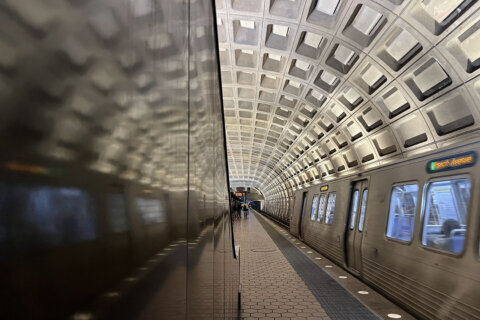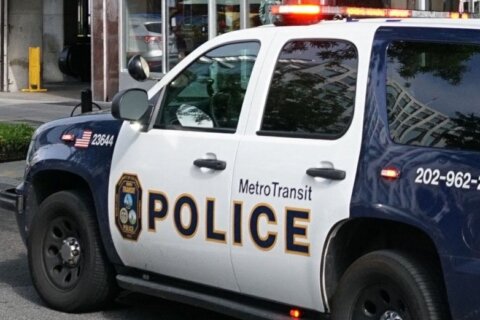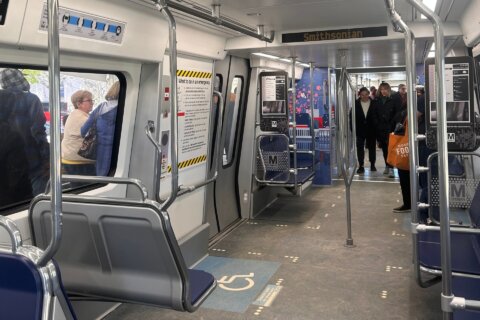WASHINGTON — The Metro work zone — which could have the largest impact on the largest number of riders of any on the schedule — started Saturday and runs through Tuesday, Nov. 22.
Regional planners expect the impact will go far beyond the rails.
Past 24/7 Metro work zones have led to increased traffic in areas affected by the surge, and this shutdown — of the Red Line tracks between Fort Totten and NoMa-Gallaudet — will result in weeks of significant service cuts along nearly the entire line.
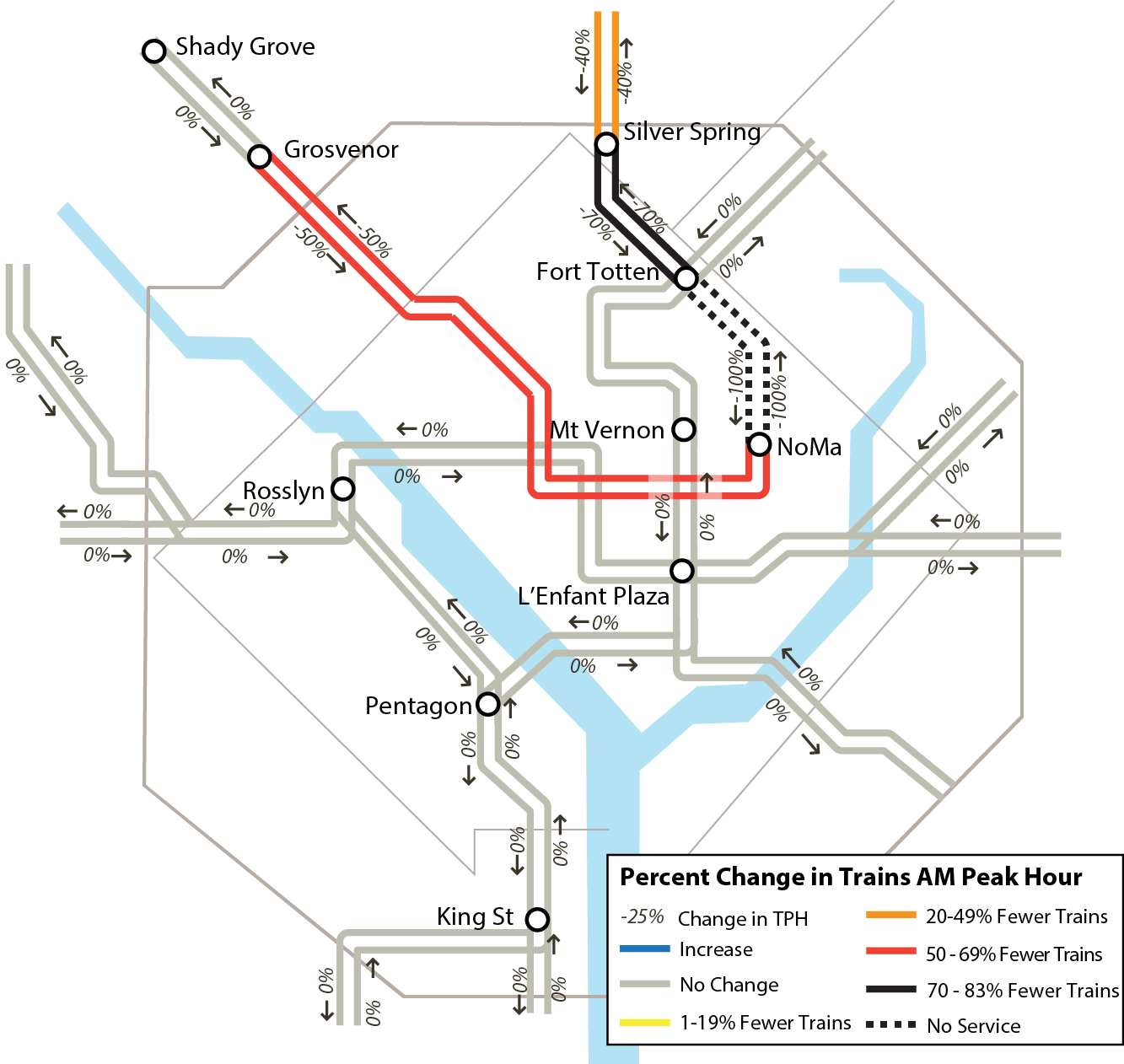
The work
For the entire period of Oct. 29 to Nov. 22, there are no trains at the Brookland-CUA or Rhode Island Avenue stations.
The shutdown also means half as many trains as usual are scheduled between Grosvenor-Strathmore and NoMa-Gallaudet, and less than a third of the usual number of trains are scheduled to run between Silver Spring and Fort Totten. The service reduction is scheduled to be 40 percent between Silver Spring and Glenmont.
Metro’s initial plans had called for more trains than usual during the morning rush hour between Grosvenor and Shady Grove, even with the cuts along the rest of the Red Line. But a revised plan now indicates that the number of trains in that stretch will be scheduled at the same level as usual.
During the shutdown, Metro plans to replace and repair equipment in locations where trains move from one track to the other, do other more general track work and attempt to repair concrete problems in and around the Rhode Island Avenue station that led to its closure and urgent inspections around Labor Day weekend. After the concrete fixes set, trains could get back to full speed in that stretch.
Due to the work and large number of work crews, Metro is also closing the Rhode Island Avenue station parking garage to the public during the entire track work period.
The workarounds
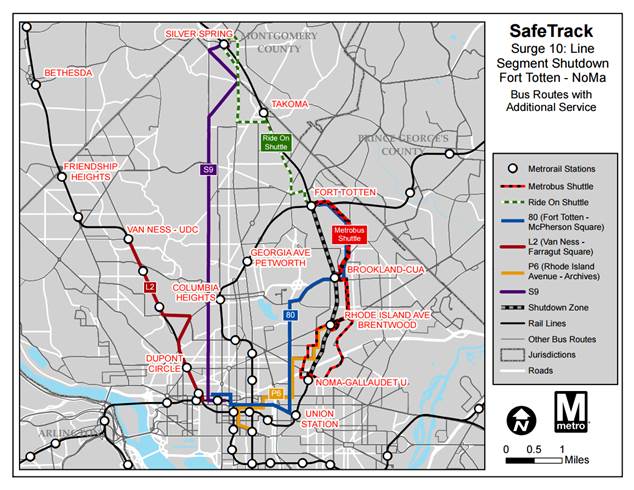
Red Line trains across the system could be even more crowded than usual, especially at rush hour, given the longer scheduled waits and reduced service. The Green and Yellow lines are scheduled to operate at normal service levels and could provide the most familiar commute for riders who typically drive to Metro stations on the eastern branch of the Red Line.
Parking spaces are typically available in the Metro garages at Greenbelt, College Park-UMD and Prince George’s Plaza.
Metro and Montgomery County’s RideOn are offering some shuttle buses, with typical Metro shuttle bus service between Fort Totten, Brookland-CUA, Rhode Island Avenue and NoMa-Gallaudet at all times the rail system is open.
During rush hour, RideOn shuttles will run every 10 minutes between Silver Spring, Takoma and Fort Totten to offer a backup option given the significantly reduced rail service in that stretch.
Metro is also adding some extra rush hour trips on the 80 bus along North Capitol Street from Fort Totten to Union Station, Metro Center and Foggy Bottom; the P6 bus between Anacostia, Navy Yard, Metro Center and Rhode Island Avenue; and the L2 bus along Connecticut Avenue NW.
The express S9 bus down 16th Street NW will also run additional service from 7 a.m. to 7 p.m. on weekdays, including buses every 20 minutes in the middle of the day when there is usually no limited-stop service in the corridor.
A number of other Metrobus and RideOn routes could also offer ways around the Red Line, including buses to and from the Silver Spring Transit Center that go to Glenmont, Bethesda, College Park, downtown D.C., Rockville and Shady Grove. The D.C. Metro stations most affected by the work are also served by a number of bus routes that may help riders around the worst of the issues.
The additional service, and awareness of all the options, could be crucial, because driving in from Montgomery County could be complicated even further by the long-term closure of Beach Drive in the District.
“This will limit its use as an alternate transportation option,” Metro advised.
The work does leave space for people biking or walking to pass through, so regional leaders are urging commuters to consider biking as an option. On the eastern side of the Red Line, the Metropolitan Branch Trail provides a route into the city.
Another available transit option is MARC’s Brunswick Line. The commuter rail service warns that the dramatic impact of Metro’s work could lead to more crowded trains at Kensington and Silver Spring. Tickets bought before boarding the train cost $5 for a trip between Kensington or Silver Spring and Union Station.
Weekly MARC tickets for either trip cost $37.50, but must be bought online about a week ahead in advance to allow time for them to arrive in the mail. As an added bonus, weekly tickets include free travel on Metrobus or RideOn. Kensington typically does not have extra parking spaces available at the station for later trains, so MARC urges riders to get dropped off, walk, bike or take the bus to the station.
Riders in the stretches of the western side of the Red Line affected by service cuts during this work could also consider using MARC’s Garrett Park or Rockville stations.
Once in D.C., the DC Circulator has expanded some early morning and evening service. The routes serving Red Line stations now begin at 6 a.m. on weekdays.
Capital Bikeshare also continues to offer single trips for $2, although riders using it more than a few times might be better off getting a longer-term membership.
For the length of this work zone, Bikeshare will run corral service at Union Station from 3:30 p.m. to 7:30 p.m., which ensures that riders always have a place to leave their bikes. The anti-“dock blocking” measure will be in place at the Columbus Circle/Union Station docks.
Capital Bikeshare plans to focus more on stations along the area where the Red Line is shutdown to re-balance bikes more often to stations that are empty.
Parking
Drivers need to carefully check the No Parking signs, since the extended rush-hour restrictions that have been rolled out on major corridors across the District since June remain in place. In many cases, that means those rules in rush-hour zones have been extended by 30 minutes.
In Montgomery County, there is no parking from 5 a.m. to 8 p.m. on weekdays during the work zone along Georgia Avenue or Colesville Road in the Silver Spring area.
The parking restrictions are in place south of Spring Street.

Cars that are towed from the restricted parking areas in Montgomery County will be taken to a lot at 8781 Georgia Ave. Drivers can call 301-279-8000 for information.
The Montgomery County Department of Transportation hopes the parking restrictions will help mitigate some of the traffic impacts of the work by opening up more lanes at the busiest times.
What’s next
After Thanksgiving, round-the-clock work shifts back to the Orange and Silver Lines.
For 24 days, from Monday, Nov. 28, to Wednesday, Dec. 21, trains will single-track between East Falls Church and West Falls Church. The work means only about one-third of the usual number of rush-hour Orange and Silver Line trains will be scheduled at stations in Fairfax County (all stations west of East Falls Church).
In Arlington, with some extra trains turning around at East Falls Church, the Orange and Silver line cuts at rush hour will be about 38 percent.
There will also be about 27 percent fewer trains than usual at the New Carrollton end of the Orange Line, and 40 percent fewer trains than usual scheduled at rush hour between Largo Town Center and Stadium-Armory.
Downtown, riders should expect about 30 percent fewer trains than usual scheduled on the Orange, Silver and Blue Line tracks.
The overall rush hour schedule calls for Silver Line trains every 16 minutes, Orange Line trains every 16 minutes between Vienna and New Carrolton, and some additional Orange Line trains between New Carrollton and East Falls Church.
The Blue Line is scheduled to run as usual, despite there being fewer Orange and Silver Line trains scheduled through the Rosslyn Tunnel.
Metro expects to announce in December the exact schedule for 24/7 work on the Blue and Yellow lines in January, February and March. It is expected to begin with weekday single-tracking and a weekend shutdown south of Braddock Road, which would be repeated in March. In late January or early February, Metro plans a complete Blue Line shutdown between Rosslyn and Pentagon.

